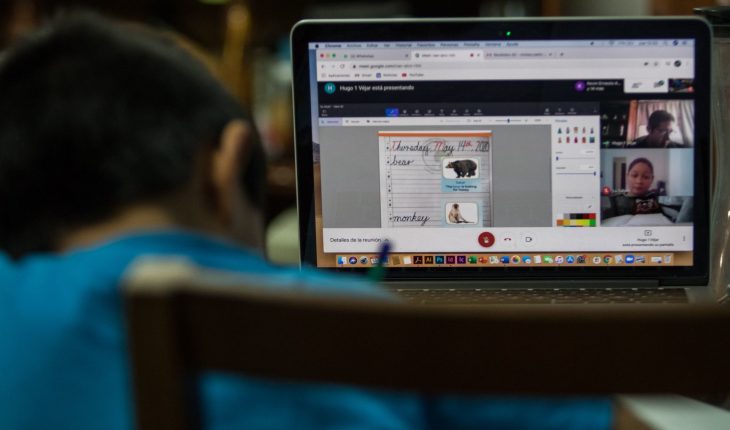Eliel is 11 years old and in this school year he will begin high school. Only neither he nor anyone imagined he would do it remotely. You’ll be enrolled in a new school, though you won’t know what your classrooms are like. You also won’t be able to meet your new teachers or peers because you’ll only be watching a TV screen at home.
Patricia Matadamas, her mother, is overwhelmed not only by what the new stage means for her son but also because she does not yet know how she will solve the pedagogical help she will require, while she and her husband are taking up their work away from home.
Read: No money or internet at home, mothers went out looking for WiFi on the street for their children’s homework
On Monday, President Andrés Manuel López Obrador and the Secretary of Education, Esteban Moctezuma, announced the federal government’s strategy with which they will teach education amid the pandemic that at the moment prevents 30 million students in Mexico from having face-to-face classes.
The school year will begin on August 24 with classes through radio and television with the program Learn at Home II. A not lesser challenge taking into account inequality in the country and the complexities between families, but which, according to the president, can be addressed thanks to the union between public and private television for teaching.
The Federal government reported on Monday night that it will pay 450 million pesos to the country’s major private television stations for this service, such as Televisa and Tv Azteca, whose owners Emilio Azcárraga and Benjamín Salinas, respectively, attended the president’s conference to sign the agreement.
Without specifying how much it will pay each television, Presidency reported that the government will pay 15 pesos for each student enrolled at preschool, elementary, high school, and high school. This would mean paying 450 million pesos for 30 million students from August to December, the period that the school year will last.
However, while ensuring that classes can be broadcast on television, in Eliel’s case, his grandparents who take care of him and his three-year-old brother while their parents go out to work, they could not be a pedagogical support for learning with this modality, while their parents still do not know what other strategies will be able to apply their new school.
Read: Students form ‘cores’ to take classes online, propose Cinvestav scientists
And so far, the PMI has also not made public any evaluation confirming the pedagogical effectiveness of the Learn at Home programme that was implemented in March; that is, you don’t know if the students actually learned.
“When the red light was there I was able to help you, but now back to work, how am I going to make sure you’re watching TV, doing your activities? Grandparents couldn’t help you. Also, before, in sixth grade, I already knew his teacher and supported, but now my son will have a gap with new teachers, subjects, school,” says Patricia.
At the evening conference headed by Secretary Moctezuma, hours after the launch of the strategy, he wondered about this issue. However, so far, the PMI has no action for these families. “We’re looking at, we’re going to have a proposal this weekend so we can see how you can help working mothers,” she replied.
He also said, “from seven o’clock at night all the programs will be repeated on the channels so that there will also be the possibility of watching the programs on a time more, let’s say, close to the night.”
AnimalMX: Frustration and Attacks: How do teachers feel with online classes?
Uncertainty
Home Learn was the strategy by which SEP tried to resolve class suspension last March because of the coronavirus pandemic.
But television didn’t work for everyone as a means of teaching. In the case of Patricia and her youngest son in preschool, it was virtually impossible to get little Joseph up at 7 a.m. to take class in front of television. A schedule that wasn’t even the usual in face-to-face classes.
While for primary and secondary school students, teachers are the stepping stone to meet this challenge in the best way, says Reyna Campuzano, primary school teacher in Altamira, Tamaulipas. “It’s impossible that it’s just television, it takes feedback, clearing doubts,” he says.
At his school teachers used whatsapp to communicate with parents, send assignments, resolve doubts and to qualify they appealed to “teaching ingenuity”. They put mesabancos outside the school gate and at a certain date and time the parents had to leave the evid notebooks theretheir school activities, then the teachers picked them up and others only sent pictures of their homework.
However, they did not know that the next school year would continue under the television modality, Reyna says. They learned the same as the rest of the population through the president’s press conference, even though teachers should have the information before the rest, since they will be the ones who do it.
In fact, when this was mentioned to the secretary of Education at the press conference, he reversed that teachers had received the information. “That’s what this program is for, and that’s what the meeting was for in the morning, that’s what phone numbers are for, they’ve gotten information, and they’ll continue to do it within a month.”
The phones the official referred to were saturated all day, Reyna says, although previously he only answered a recording on three topics: bullying, doubts about Home Learn and psychological support. But the doubts at this time is even, whether they could make use of other tools, or the contents that the classes will have on television, which they have not yet indicated to them.
Saúl Pérez, a primary school teacher in Mexico City, said strange to today’s announcement, especially since 15 days ago he was invited to take a training on “Google classroom”, the technology company’s tool for teaching remotely.
“There is no clarity. They’re officializing The Learn at Home, but we don’t even know if they’re going to give us autonomy to apply other tools. What good is it if I’m training in these tools if I’m not going to be able to use them,” he says.
In fact, last week the PMI taught an intensive course to prepare for a return to school, but especially with regard to the new subject of Healthy Living, but on Wednesday it stopped and the following instructions would come “until further notice but we do not yet know what is next.
Do they really learn on TV?
Luis Ramírez, high school principal at Zapopan Jalisco and coach of Google, says that “there is not much basis to say whether a student learned through television or not”, but something is true “you always need instruction from a teacher pedagogically or you are on water”.
Teachers and parents need clarity from schedules and channel tuning to basic recommendations such as the conditions for taking classes in front of a television in the room where they all “pass” and there are permanent distracting elements, or how to solve the problem of having only one television equipment for multiple children in one house.
Marco Antonio Fernández, researcher from Mexico’s Evaluates and School of Government of Tec de Monterrey, argues that television is not a new tool in the Mexican education system, but it has been shown that it has not been effective with the telesecondary model, even though there is even a “facilitator”, that is, a teacher who solves doubts. However, “in test results like Link and Planea, the worst performers are telesecondary ones.”
For example, in the Plan 2017 results for third high school students, 33% of students nationwide had insufficient results in Language and Communication. But in private schools, only 10.6% achieved that result, and in telesecondary people the figure was up to 48.8%.
In Mathematics, the percentage of under-level pupils was 64.5% in the country; but only 37% of those studying privately had that result, while in telesecundary it stood at that level 69.9% of the students.
Education through television could “widen” inequalities and we will see the effects after years, because unlike the health sector, the consequences of which are immediately observed, in the education sector will be seen in “truncated or incomplete educations that will not eventually allow them to enter the world of work”, says Fernández.
This is because parents who do have resources and education will more effectively support their children, be able to bring them tutoring, and have classes through platforms while there will be parents who will not be able to be with their children at home. Distance education will be widening educational inequalities,” says the researcher.
And you also have “one of the big problems that are single-parent families, single moms. That’s going to make the situation more complicated for these types of households.”
By asking Secretary Esteban Moctezuma about the measurements they would have made about the Learn at Home program and the findings on pedagogical effectiveness, the official responded that he will prepare a presentation with the data for the next few days.
What we do in Animal Politics requires proe proe journaliststeamwork, dialogue with readers and something very important: independence. You can help us keep going. Be part of the team.
Subscribe to Animal Politics, receive benefits and support free journalism #YoSoyAnimal.
translated from Spanish: Sep will pay 450 mdp to TVs for broadcasting classes on radio and tv
August 4, 2020 |





